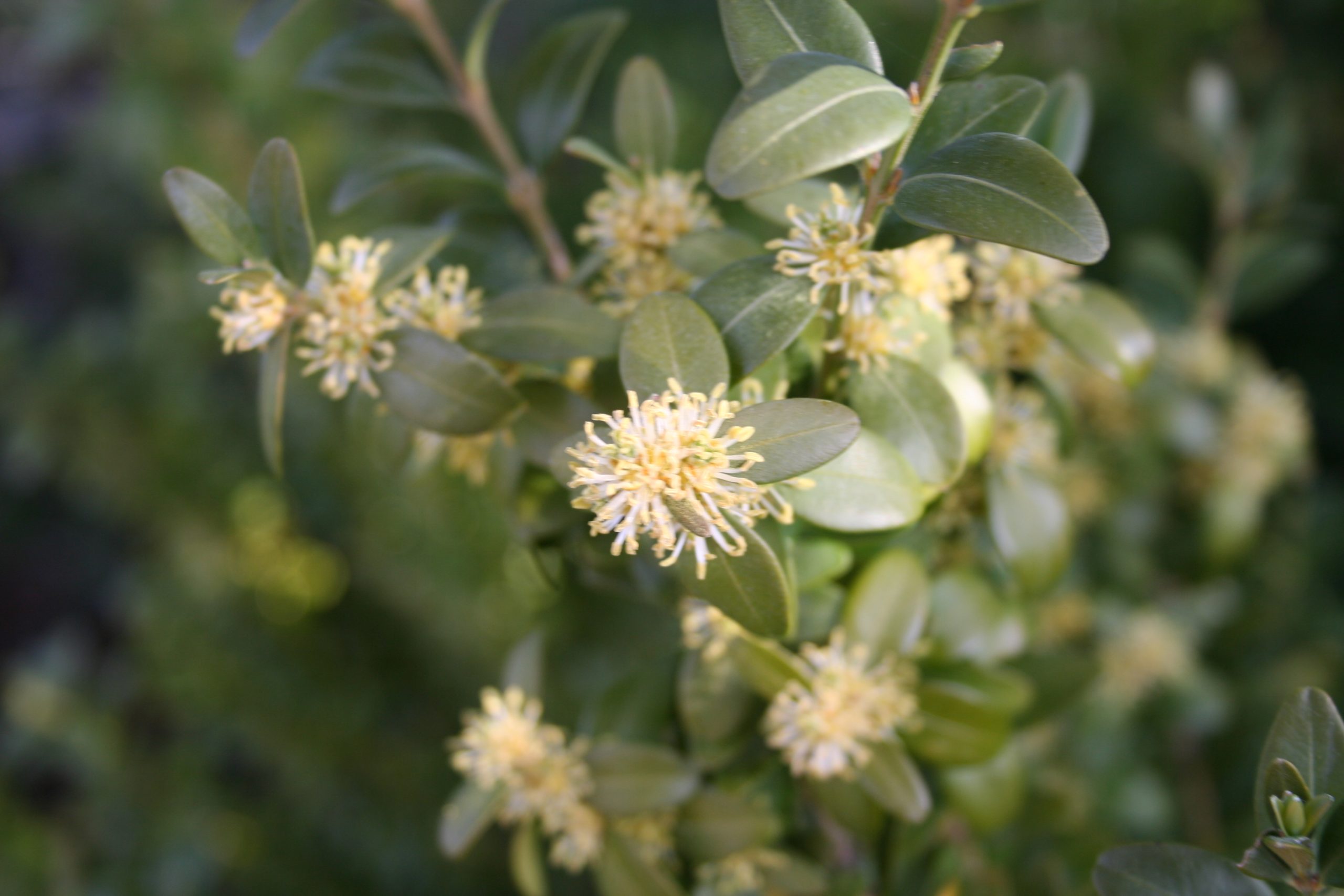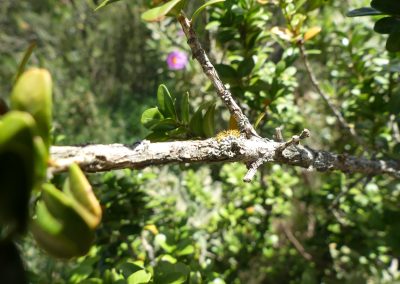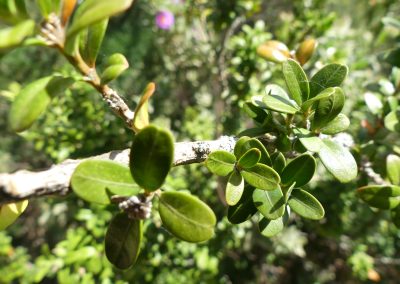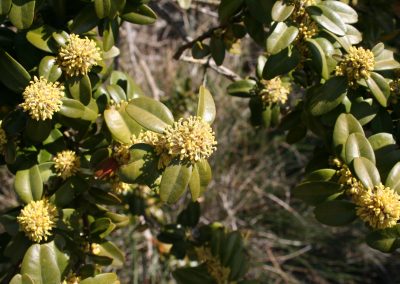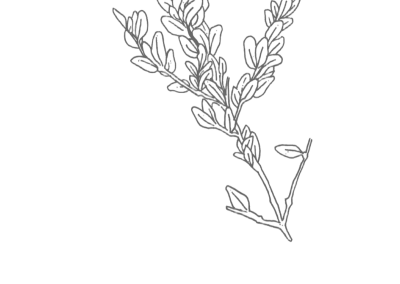Buxus sempervirens
Scientific description
Taxon: Buxus sempervirens
Class: Dicotyledons (Magnoliopsida)
Subclass: Hamamelididae (or Eudicotyledons depending on classification)
Order: Buxales
Family: Buxaceae
Common name: Common boxwood
Origin:
Southern and Western Europe, North Africa, Western Asia.
Description:
Buxus sempervirens is an evergreen shrub or small tree reaching up to 6 meters in height. Its leaves are small, oval, leathery, dark green, opposite, and glossy. The flowers, inconspicuous, are yellow-green and appear in spring.
Boxwood is known for its slow growth and hard, dense, yellow wood, used in cabinetmaking and sculpture. It is often planted as trimmed hedges or topiaries due to its ability to withstand precise pruning. Its dense and compact foliage makes it ideal for formal and French-style gardens.
Propagation:
Mainly by cuttings in summer; seed germination is slow and less common.
Ecology:
Naturally grows in open woodlands on calcareous, well-drained soils. Drought-tolerant and shade-tolerant, it plays an important role for pollinators in spring.
Use:
• Ornamental (hedges, topiaries)
• Wood valued in carving and engraving
• Limited traditional medicinal use
Threat:
Locally threatened by box tree moth (Cydalima perspectalis) and fungal diseases, causing significant decline in some areas.
Taxon : Buxus sempervirens
Classe : Dicotylédones (Magnoliopsidées)
Sous-classe : Hamamelididées (ou Eudicotylédones selon les classifications)
Ordre : Buxales
Famille : Buxacées
Nom commun : Buis commun
Origine :
Europe méridionale et occidentale, Afrique du Nord, Asie occidentale.
Description :
Buxus sempervirens est un arbuste ou petit arbre à feuillage persistant, pouvant atteindre jusqu’à 6 mètres de hauteur. Ses feuilles sont petites, ovales, coriaces, vert foncé, opposées et brillantes.
Les fleurs, peu visibles, sont jaune verdâtre et apparaissent au printemps. Le buis est réputé pour sa croissance lente et son bois dur, dense et jaune, utilisé en ébénisterie et sculpture.
Il est souvent planté en haies taillées ou en topiaires grâce à sa capacité à supporter des tailles très précises. Son feuillage dense et compact le rend idéal pour les jardins formels et à la française.
Propagation :
Principalement par bouturage en été ; la germination des graines est lente et moins courante.
Écologie :
Il pousse naturellement dans les sous-bois clairs, sur sols calcaires et bien drainés. Résistant à la sécheresse et à l’ombre partielle, il joue un rôle important pour les pollinisateurs au printemps.
Utilisation :
• Utilisé en ornement (haies, topiaires)
• Bois apprécié en sculpture et gravure
• Usage médicinal limité et traditionnel
Menace:
Menacé localement par la pyrale du buis (Cydalima perspectalis) et des maladies fongiques, causant un déclin important dans certaines régions.
Taxon: Buxus sempervirens
Clasă: Dicotiledonate (Magnoliopsida)
Subclasă: Hamamelidide (sau Eudicotiledonate, în funcție de clasificare)
Ordin: Buxales
Familie: Buxaceae
Denumire populară: Cimișir / Merișor
Origine:
Europa de sud și vest, Africa de Nord, Asia de vest.
Descriere:
Buxus sempervirens este un arbust sau copac mic cu frunziș veșnic verde, care poate ajunge până la 6 metri înălțime. Frunzele sunt mici, ovale, coriacee, verde închis, opuse și lucioase.
Florile, puțin vizibile, sunt galben-verzui și apar primăvara. Buxus este cunoscut pentru creșterea sa lentă și lemnul dur, dens și galben, folosit în tâmplărie și sculptură.
Este adesea plantat în garduri vii tăiate sau topiare datorită capacității sale de a suporta tăieri precise. Frunzișul dens și compact îl face ideal pentru grădini formale și în stil francez.
Propagare:
În principal prin butași vara; germinarea semințelor este lentă și mai rară.
Ecologie:
Crește natural în păduri deschise, pe soluri calcaroase și bine drenate. Rezistent la secetă și umbră parțială, joacă un rol important pentru polenizatori primăvara.
Utilizare:
• Utilizat ornamental (garduri vii, topiare)
• Lemn apreciat în sculptură și gravură
• Utilizare medicinală limitată și tradițională
Amenințări:
Amenințat local de molia buxusului (Cydalima perspectalis) și boli fungice, cauzând un declin semnificativ în unele zone.
Ταξινόμηση: Buxus sempervirens
Κλάση: Δικοτυλήδονα (Magnoliopsida)
Υποκλάση: Χαμαιμελίδιες (ή Ευδικοτυλήδονα ανάλογα με την ταξινόμηση)
Τάξη: Buxales
Οικογένεια: Buxaceae
Κοινό όνομα: Κουτσουπιά κοινή
Προέλευση:
Νότια και Δυτική Ευρώπη, Βόρεια Αφρική, Δυτική Ασία.
Περιγραφή:
Το Buxus sempervirens είναι ένας αειθαλής θάμνος ή μικρό δέντρο που μπορεί να φτάσει τα 6 μέτρα ύψος. Τα φύλλα του είναι μικρά, ωοειδή, δερματώδη, σκούρου πράσινου χρώματος, αντίθετα και γυαλιστερά.
Τα άνθη, δυσδιάκριτα, είναι κιτρινοπράσινα και εμφανίζονται την άνοιξη. Η κουτσουπιά είναι γνωστή για την αργή ανάπτυξή της και το σκληρό, πυκνό, κίτρινο ξύλο της, που χρησιμοποιείται στην επιπλοποιία και γλυπτική.
Συχνά φυτεύεται σε καλλωπιστικούς φράχτες ή τοπιά λόγω της αντοχής της σε ακριβές κλαδέματα. Τα πυκνά και συμπαγή φύλλα την καθιστούν ιδανική για επίσημους και γαλλικού τύπου κήπους.
Διάδοση:
Κυρίως με μοσχεύματα το καλοκαίρι· η βλάστηση των σπόρων είναι αργή και λιγότερο συχνή.
Οικολογία:
Φυσικά αναπτύσσεται σε φωτεινά δάση σε ασβεστολιθικά και καλά αποστραγγιζόμενα εδάφη. Ανθεκτικό στην ξηρασία και μερική σκιά, παίζει σημαντικό ρόλο για τους επικονιαστές την άνοιξη.
Χρήσεις:
• Καλλωπιστικό (φράχτες, τοπιά)
• Ξύλο εκτιμώμενο στη γλυπτική και χαρακτική
• Περιορισμένη παραδοσιακή φαρμακευτική χρήση
Απειλές:
Τοπικά απειλείται από την πυραλίδα της κουτσουπιάς (Cydalima perspectalis) και μυκητιασικές ασθένειες, προκαλώντας σημαντική μείωση σε ορισμένες περιοχές.
Creative writing inspired by Buxus sempervirens
The Boxwood
In a small, forgotten corner of the Earth, deep in an ancient forest, grew a shrub unlike any other. It was called Boxwood, and although it looked like any ordinary shrub, it had a unique ability: it could purify the air of all kinds of pollution. Its leaves absorbed toxins and carbon dioxide and released pure, clean oxygen.
No one knew of its power, not even the animals of the forest. Until one day, the world was faced with a serious crisis. The atmosphere had become so polluted that people began to find it hard to breathe. Factories, exhaust fumes and the destruction of forests had made the air almost lethal.
A group of scientists, desperate for a solution, heard an old story about a mysterious bush that could purify the atmosphere. Guided by an old druid, they found the ancient forest and met Boxwood.
By taking samples of its leaves and analyzing them, they realized that they held the salvation of mankind in their hands. With the help of biologists and agronomists, they were able to grow thousands of new plants based on Boxwood. Within a few years, these unique plants were planted in cities, streets and industrial areas. Little by little, pollution decreased and the world regained its balance.
Boxwood had saved the world. And although no one ever gave it a medal or a place in history, every time someone breathed clean air, they felt at ease.


